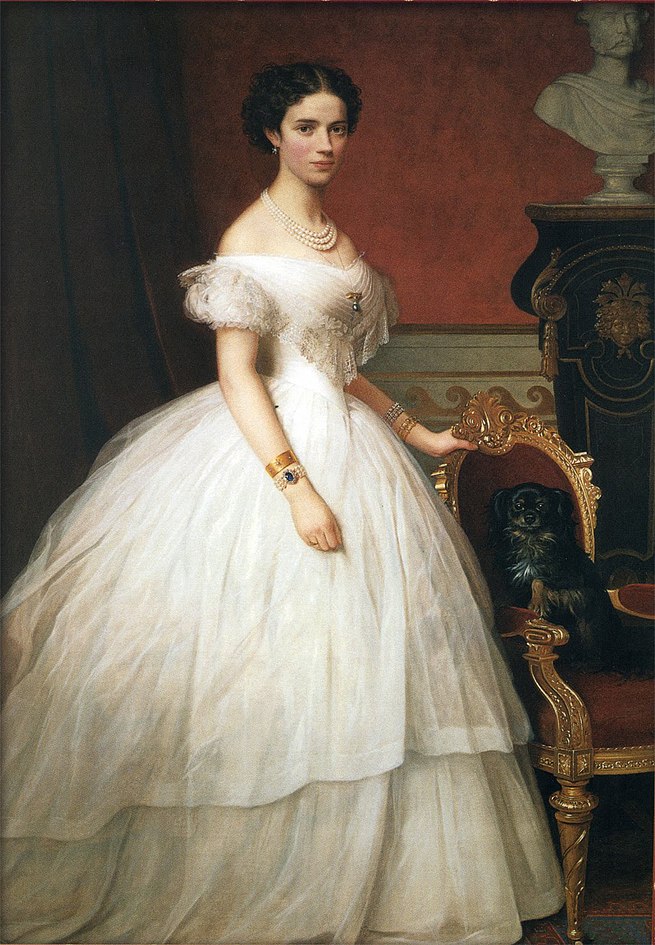
Main Difference
The main difference between Crinoline and Farthingale is that the Crinoline is a petticoat and Farthingale is a supports in the form of hoops or padded rolls, worn beneath a skirt to add fullness, worn in the 16th and 17th centuries
-
Crinoline
A crinoline is a stiff or structured petticoat designed to hold out a woman’s skirt, popular at various times since the mid-19th century. Originally, crinoline described a stiff fabric made of horsehair (“crin”) and cotton or linen which was used to make underskirts and as a dress lining.
By the 1850s the term crinoline was more usually applied to the fashionable silhouette provided by horsehair petticoats, and to the hoop skirts that replaced them in the mid-1850s. In form and function these hoop skirts were similar to the 16th- and 17th-century farthingale and to 18th-century panniers, in that they too enabled skirts to spread even wider and more fully.
The steel-hooped cage crinoline, first patented in April 1856 by R.C. Milliet in Paris, and by their agent in Britain a few months later, became extremely popular. Steel cage crinolines were mass-produced in huge quantity, with factories across the Western world producing tens of thousands in a year. Alternative materials, such as whalebone, cane, gutta-percha and even inflatable caoutchouc (natural rubber) were all used for hoops, although steel was the most popular. At its widest point, the crinoline could reach a circumference of up to six yards, although by the late 1860s, crinolines were beginning to reduce in size. By the early 1870s, the smaller crinolette and the bustle had largely replaced the crinoline.
Crinolines were worn by women of every social standing and class across the Western world, from royalty to factory workers. This led to widespread media scrutiny and criticism, particularly in satirical magazines such as Punch. They were also hazardous if worn without due care. Thousands of women died in the mid-19th century as a result of their hooped skirts catching fire. Alongside fire, other hazards included the hoops being caught in machinery, carriage wheels, gusts of wind, or other obstacles.
The crinoline silhouette was revived several times in the 20th century, particularly in the late 1940s as a result of Christian Dior’s “New Look” of 1947. The flounced nylon and net petticoats worn in the 1950s and 1960s to poof out skirts also became known as crinolines even when there were no hoops in their construction. In the mid-1980s Vivienne Westwood designed the mini-crini, a mini-length crinoline which was highly influential on 1980s fashion. Late 20th and early 21st century designers such as John Galliano and Alexander McQueen have become famous for their updated crinoline designs. Since the 1980s and well into the 21st century the crinoline has remained a popular option for formal evening dresses, wedding dresses, and ball gowns.
-
Farthingale
A farthingale is one of several structures used under Western European women’s clothing in the 16th and 17th centuries to support the skirts in the desired shape and enlarged the lower half of the body. It originated in Spain in the fifteenth century. Farthingales served important social and cultural functions for women in Renaissance Europe as they were used, primarily by court women, to show their high social position and wealth. This is because these structures increased the amount of expensive fabrics used in the gowns that covered them.
-
Crinoline (noun)
A stiff fabric made from cotton and horsehair.
-
Crinoline (noun)
A stiff petticoat made from this fabric.
-
Crinoline (noun)
A skirt stiffened with hoops.
-
Crinoline (noun)
Any of the hoops making up the framework used to support cladding over a boiler.
-
Crinoline (noun)
Netting placed around ships to guard against torpedoes.
-
Farthingale (noun)
A hooped structure in cloth worn to extend the skirt of women’s dresses; a hooped petticoat.
